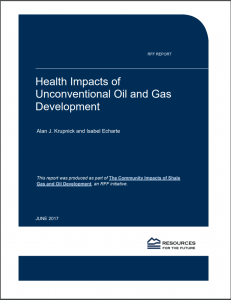Full Title: Health Impacts of Unconventional Oil and Gas Development
Author(s): Alan J. Krupnick & Isabel Echarte
Publisher(s): Resources For the Future
Publication Date: June 1, 2017
Full Text: Download Resource
Description (excerpt):
This report reviews the academic literature analyzing the effect of unconventional oil and gas development on health outcomes—i.e., for a study to be reviewed, it must link unconventional oil and gas development to some measure of health impact or risk. We classify the literature according to methodologies used—epidemiological, health impact assessments, community based participatory research, occupational health, and hypothesis-generating studies. We chose to focus the majority of our analysis on epidemiological studies, as these studies directly address associations between health outcomes and oil and gas development. We do not include toxicological studies analyzing health effects on animals. The health impacts literature reviews are additionally accompanied by a “span chart,” which summarizes the literature along a key dimension: which elements of the damage function model (which links oil and gas activities to burdens, concentrations, exposures, and impacts) are covered by a given study. In all, 32 studies were reviewed, covering the following health impacts: birth outcomes, cancer, asthma, and other health effects such as migraines and hospitalization. Occupational health studies also addressed exposure to certain pollutants (such as silica and volatile organic compounds), and a number of hypothesis-generating studies analyzed burdens and concentrations (such as water and air samples) in order to assess the potential for health impacts. The literature is furthermore summarized (by impact) in the health section of the Risk-Benefit Matrix1 below, indicating the relationship between this impact, as reported across the literature, and unconventional oil and gas development as well as the quality of the body of research assessing that impact.
